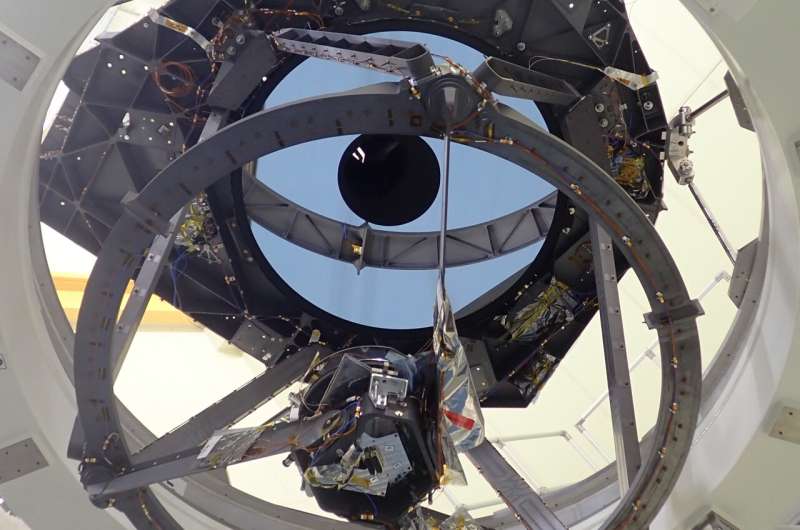Exploring Euclid’s Korsch configuration mirrors

The 1.2-m diameter main mirror of ESA’s Euclid mission to unveil the dark universe, seen during assembly, integration and testing. Using this mirror, the spacecraft will map the 3D distribution of billions of galaxies up to 10 billion light years away—looking beyond the Milky Way galaxy to image around a third of the observable universe. By revealing the universe’s large-scale structure, and its pattern of expansion, the mission will cast light on the mysterious dark energy and dark matter making up 95% of the cosmos.
All six of Euclid’s Korsch configuration mirrors, plus the telescope itself—comprising more than 30 parts as well as the mirrors—as well as the more than 10 parts making up the mission’s Near Infrared Spectrometer and Photometer and the optical bench that surrounds them are all made from the same material: not glass, but a ceramic only found naturally in space.
Silicon carbide (SiC) is one of the hardest materials known, used to make cutting tools, high-performance brakes and even bulletproof vests, while being much lighter than glass. It is similar to a metal in having high thermal conductivity but unlike metals can undergo extreme temperature shifts without deforming—making it very attractive for space-based astronomy.
SiC is relatively common in space—formed from the combination of silicon and carbon in the absence of oxygen—and small amounts of it have been found within meteorites. On Earth it was first synthesized as an artificial diamond substitute.
Realizing its potential for space, ESA and Airbus (developing Euclid’s payload module) entered into a long-term technical collaboration with French company Mersen Boostec, born out of a terrestrial firm which previously manufactured SiC bearings and seals for industrial pumps. The company made the 3.5-m diameter main mirror for ESA’s Herschel spacecraft—which when the mission launched in 2009 was then the largest telescope mirror flown to space—and went on to produce mirrors and optical supports for Rosetta, Gaia, the James Webb Space Telescope and now Euclid.
“Gaia’s monolithic rectangular main mirror had a wider diameter at 1.5 m across, but Euclid’s main mirror represents our company’s largest made-in-one circular mirror,” explains engineer Florent Mallet of Mersen Boostec.
The company’s SiC Product Line Director, Jérôme Lavenac, adds, “We’re proud of our contribution to Europe’s latest space astronomy mission, which will lead to major advances in fundamental physics.”
The main mirror’s manufacturing process began with SiC powder which was squeezed into a solid but soft circular block which was then precisely shaped using a computer-guided milling machine. The next step was sintering, or baking it in a 2,100°C oven. The resulting hard ceramic was then coated with additional SiC using chemical deposition, to fill in any residual pores, to a thickness of a few tenths of a millimeter. The mirror was then ground slightly before being passed to the Safran-Reosc company for polishing and silver coating. The final mirror shape is accurate to nine millionths of a millimeter under Earth gravity.
Both of Euclid’s instruments will make use of this mirror plus its five smaller ones. Euclid’s VISible instrument (VIS) takes very sharp images of galaxies in visible light over a much larger fraction of sky than would be possible from the ground. VIS works alongside the Near Infrared Spectrometer and Photometer (NISP). NISP sifts infrared light coming from these galaxies to derive key data, including their speed of outward expansion—measuring their “redshift,” on the same principle as a police radar gun, which will in turn allow astronomers to infer the expansion history of the universe.
Citation:
Exploring Euclid’s Korsch configuration mirrors (2023, June 28)
retrieved 28 June 2023
from https://phys.org/news/2023-06-exploring-euclid-korsch-configuration-mirrors.html
This document is subject to copyright. Apart from any fair dealing for the purpose of private study or research, no
part may be reproduced without the written permission. The content is provided for information purposes only.
For all the latest Science News Click Here
For the latest news and updates, follow us on Google News.

